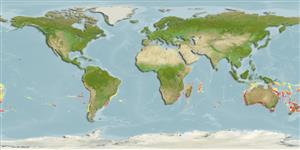Common names from other countries
>
Scombriformes (Mackerels) >
Trichiuridae (Cutlassfishes) > Aphanopodinae
Etymology: Benthodesmus: Greek, benthos = depth of the sea + Greek, desmos = bond, chain (Ref. 45335).
Environment: milieu / climate zone / depth range / distribution range
Ecología
marino bentopelágico; rango de profundidad 178 - 950 m (Ref. 6181). Deep-water; 9°S - 44°S, 30°E - 26°W (Ref. 6181)
Atlantic, Indian and Pacific: off south Brazil and Argentina, Rio Grande Rise, southeastern Africa, Madagascar Ridge, southeastern Australia, New Zealand, Sala y Gomez Ridge.
Length at first maturity / Tamaño / Peso / Age
Maturity: Lm ?, range 57 - ? cm
Max length : 100.0 cm TL macho / no sexado; (Ref. 9351)
Espinas dorsales (total) : 42 - 46; Radios blandos dorsales (total) : 99 - 108; Espinas anales: 2; Radios blandos anales: 91 - 98; Vértebra: 151 - 159. Body silvery, jaws and opercle blackish. The inside of the mouth and gill cavities black.
Juveniles mesopelagic (Ref. 6181); also benthopelagic (Ref. 5951). Feeds on crustaceans (mainly prawns and euphausiids), small fishes (e.g. Maurolicus) and squid (Ref. 6202). Minimum depth reported from Ref. 36453.
Life cycle and mating behavior
Maturities | Reproducción | Spawnings | Egg(s) | Fecundities | Larva
Batch spawners with 5,000 to 16,000 eggs per spawn.
Nakamura, I. and N.V. Parin, 1993. FAO Species Catalogue. Vol. 15. Snake mackerels and cutlassfishes of the world (families Gempylidae and Trichiuridae). An annotated and illustrated catalogue of the snake mackerels, snoeks, escolars, gemfishes, sackfishes, domine, oilfish, cutlassfishes,. scabbardfishes, hairtails, and frostfishes known to date. FAO Fish. Synop. 125(15):136 p. (Ref. 6181)
IUCN Red List Status (Ref. 130435)
CITES (Ref. 128078)
Not Evaluated
Threat to humans
Harmless
Human uses
Herramientas
Special reports
Download XML
Fuentes de Internet
Estimates based on models
Preferred temperature (Ref.
115969): 8.9 - 17.1, mean 11.7 (based on 175 cells).
Phylogenetic diversity index (Ref.
82804): PD
50 = 0.5005 [Uniqueness, from 0.5 = low to 2.0 = high].
Bayesian length-weight: a=0.00014 (0.00008 - 0.00025), b=3.10 (2.93 - 3.27), in cm Total Length, based on LWR estimates for this species & (Sub)family-body (Ref.
93245).
Nivel trófico (Ref.
69278): 3.9 ±0.66 se; based on food items.
Resiliencia (Ref.
120179): Bajo, población duplicada en un tiempo mínimo de 4.5-14 años (tm=5-6).
Fishing Vulnerability (Ref.
59153): High vulnerability (60 of 100).
